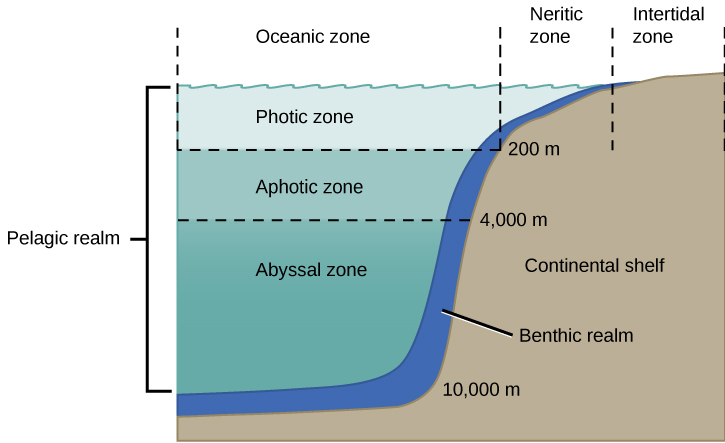| << Chapter < Page | Chapter >> Page > |
The deepest part of the ocean is the abyssal zone , which is at depths of 4000 m or greater. The abyssal zone ( [link] ) is very cold and has very high pressure, high oxygen content, and low nutrient content. There are a variety of invertebrates and fishes found in this zone, but the abyssal zone does not have photosynthetic organisms. Chemosynthetic bacteria use the hydrogen sulfide and other minerals emitted from deep hydrothermal vents. These chemosynthetic bacteria use the hydrogen sulfide as an energy source and serve as the base of the food chain found around the vents.

In which of the following regions would you expect to find photosynthetic organisms?
Coral reefs are ocean ridges formed by marine invertebrates living in warm shallow waters within the photic zone of the ocean. They are found within 30˚ north and south of the equator. The Great Barrier Reef is a well-known reef system located several miles off the northeastern coast of Australia. Other coral reefs are fringing islands, which are directly adjacent to land, or atolls, which are circular reefs surrounding a former island that is now underwater. The coral-forming colonies of organisms (members of phylum Cnidaria) secrete a calcium carbonate skeleton. These calcium-rich skeletons slowly accumulate, thus forming the underwater reef ( [link] ). Corals found in shallower waters (at a depth of approximately 60 m or about 200 ft) have a mutualistic relationship with photosynthetic unicellular protists. The relationship provides corals with the majority of the nutrition and the energy they require. The waters in which these corals live are nutritionally poor and, without this mutualism, it would not be possible for large corals to grow because there are few planktonic organisms for them to feed on. Some corals living in deeper and colder water do not have a mutualistic relationship with protists; these corals must obtain their energy exclusively by feeding on plankton using stinging cells on their tentacles.
In this National Oceanic and Atmospheric Administration (NOAA) video , marine ecologist Dr. Peter Etnoyer discusses his research on coral organisms.
Coral reefs are one of the most diverse biomes. It is estimated that more than 4000 fish species inhabit coral reefs. These fishes can feed on coral, the cryptofauna (invertebrates found within the calcium carbonate structures of the coral reefs), or the seaweed and algae that are associated with the coral. These species include predators, herbivores, or planktivores. Predators are animal species that hunt and are carnivores or “flesh eaters.” Herbivores eat plant material, and planktivores eat plankton.

Notification Switch
Would you like to follow the 'Concepts of biology' conversation and receive update notifications?